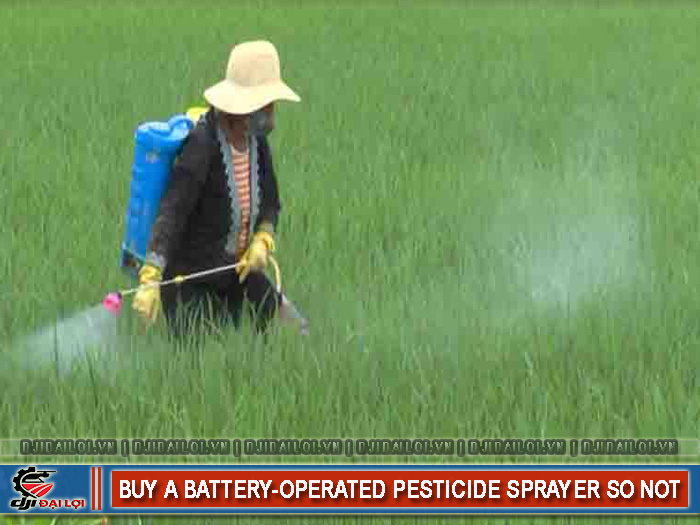
A battery-powered pesticide sprayer uses rechargeable batteries to power the pump that generates pressure to push the liquid through the nozzle. Unlike gasoline sprayers, it runs on an electric motor, without fossil fuel. The system operates via a piston or diaphragm pump, creating a stable, even spray flow with minimal vibration. This makes it an ideal choice for users seeking a safe, convenient, and eco-friendly electric pesticide sprayer. For genuine, high-quality products, many farmers prefer authorized distributors such as DJI Đại Lợi, which specialize in agricultural spraying technology.
This distinction helps farmers decide when to use a battery pesticide sprayer and when a gasoline model is more appropriate.
Widely used for:
Thanks to its mobility, cordless pesticide sprayers are becoming increasingly popular in sustainable agriculture.
No manual pumping required-simply charge the battery and spray continuously. For plots of 1,000–2,000 m², spraying time is cut in half compared to manual sprayers.
Stable pressure ensures even dispersion, minimizing direct contact with chemicals and reducing risks of inhalation or skin exposure.
Battery-powered sprayers run quietly and emit no CO₂, making them environmentally friendly compared to gasoline sprayers.
No need to buy fuel or replace spark plugs frequently-just charge or replace the battery every few years. Long-term costs are significantly lower.
A full charge typically lasts 3–5 hours, depending on capacity and output. This can interrupt spraying on large fields.
Battery sprayers often produce less pressure, limiting spray distance and coverage for tall crops.
Batteries must be charged and discharged correctly and stored in a cool, dry place to ensure longevity.
→ For large farms, gasoline sprayers have the advantage. However, agricultural drones are increasingly used for superior coverage.
→ Long-term, battery sprayers are more economical for smallholders.
For small gardens under 2,000 m², a 16–20L tank is sufficient. For larger orchards, 25–30L helps reduce refill frequency and optimize efficiency.
Choose at least 0.25–0.35 MPa for vegetables, or above 0.4 MPa for taller fruit trees. Some premium electric sprayers allow adjustable pressure for even coverage.
A single charge usually supports 3–5 hours of spraying. Opt for lithium-ion batteries ≥12Ah capacity, with charging times of 5–7 hours. Keep a spare battery for large areas.
Brands like Oshima, Honda, and Royal offer strong warranties and readily available replacement parts-ensuring quality and long-term safety.
Prices range from ₫1,500,000 to ₫4,500,000. Models under ₫2 million suit small gardens, while those above ₫3 million often include dual pumps or higher battery capacity.
Larger tanks, stronger pumps, or higher battery capacity lead to higher prices.
Purchase from authorized dealers or reputable agricultural supply stores. When buying online, check product ratings and warranty terms carefully to avoid counterfeit items.
Ideal for home gardens, small vegetable plots, and mid-sized orchards. For areas over 5 hectares, gasoline sprayers or agricultural drones are more efficient.
Battery models reduce operating costs by 30–40% compared to gasoline types, with lower maintenance expenses.
A battery-powered pesticide sprayer is a practical solution for farmers seeking a compact, cost-efficient, and safe spraying tool. Despite limitations in power and runtime, it remains the best choice for small and medium-scale farming. Choose models with suitable tank capacity, pressure, and trusted brand warranties to ensure long-term durability.
Ultimately, whether to buy a battery pesticide sprayer depends on your farm size, spraying frequency, and budget. For economical, quiet, and easy operation, it’s a great option. For larger areas or stronger spray requirements, consider gasoline sprayers or modern agricultural drones instead.
No, it’s designed only for liquid solutions. Use a granule spreader or a gasoline sprayer for solid formulations.
Yes. Replacement batteries are widely available at authorized dealers. Always use compatible models for safety and durability.
Yes, it can also spray foliar fertilizers or microbial solutions when properly diluted.
No. Rain may damage the battery and dilute the spray solution. Operate only in dry conditions.
Yes. Inspect the nozzle before each use to avoid clogging and ensure even spray distribution.